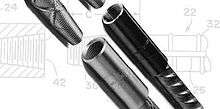Mechanical connections
Mechanical rebar connections, also known as mechanical splices, are used to join lengths of rebar together. Building code requirements for masonry construction now require longer lap lengths for some bar sizes.

Rebar Coupler
These changes mean more congestion in masonry cells and more difficult construction. To alleviate this problem, builders can either use open-cell blocks, which are more expensive, or use mechanical rebar couplers to eliminate the lap. Reinforcing bar coupling has all of the features desirable in a rebar joining system combined with unequalled simplicity of installation. Couplers are designed to splice the same diameter bars where one bar is free to move and can be rotated.
Benefits of using a mechanical rebar connection include:
- A self-aligning taper-threaded design provides continuity and structural integrity
- Spliced bars behave as continuous lengths of reinforcing steel bars by providing full strength in tension and compression and stress reversal applications
- Quick and easy to install
- Develops higher tensile strength than lap splicing in reinforced concrete.
References
- Orsman, Richard (2011). Mechanical Splicing , 08 (Devoran Metals).
External links
This article is issued from Wikipedia. The text is licensed under Creative Commons - Attribution - Sharealike. Additional terms may apply for the media files.